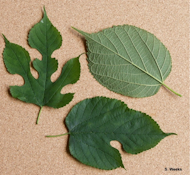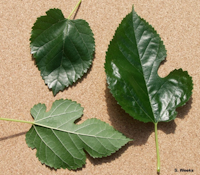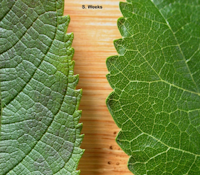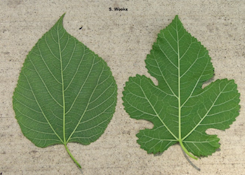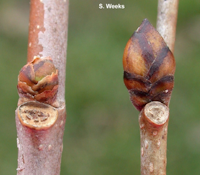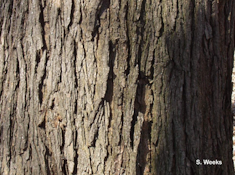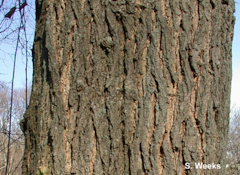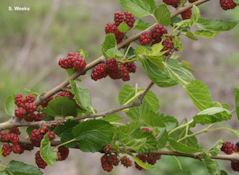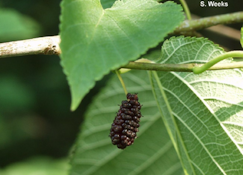Leaves occur in
three general
shapes in both species – entire, mitten (single lobed), and
three-lobed. Red mulberry leaves (Fig. 1) are usually larger (4-10
inches) than white (3-4 inches) (Fig. 2). Red mulberry has dull, dark
green leaves that are scabrous (rough) on top and usually lightly hairy
beneath. Minor veins are numerous and obvious. Its margins are usually
finely serrate when compared to those of white mulberry (Fig. 3).
White
mulberry leaves are bright green (usually) and shiny above (usually).
If any hairs are present, they occur on the main veins beneath. The
margins usually have larger, more rounded teeth. The main veins
underneath are very prominent compared to those of red mulberry (Fig.
4).
Red mulberry has larger, more
flattened buds that often sit off-center on the twig; the margin of
each scale has a black band (Fig. -5R). White mulberry buds are smaller
and more
domed in the middle, and they usually sit along the center of the twig.
The tip of each white mulberry bud is short and needle sharp, and each
bud scale has a brown band which is not necessarily on the margin(Fig.
-5L).
There is usually a color difference in the twigs of the two species as
well. Red mulberry twigs are very pale tan, while those of white
mulberry tend to be pinkish-brown.
Red
mulberry bark (Fig. 6) is grayish with flattened, scaly ridges. If
inner bark is exposed, it tends to be tan-colored. White mulberry bark
has thick, braiding ridges that are tannish-brown (Fig. 7).
The
yellowish inner bark is nearly always exposed between ridges.
The
fruit of mulberry technically known as a drupe; it is juicy, sweet,
flavorful, and a delight of summer. It is relished by many birds and
mammals, including humans. Red mulberry fruit is generally larger
(>1 inch) (Fig. 8) and sweeter than white (3⁄4 inch), and since
it
is almost always found in shady, wooded areas where it produces a
sparse fruit crop. Single fruits hang along the twig, in contrast to
the clusters of abundant, axillary fruit usually present on white
mulberry. Red mulberry fruit is always nearly black when ripe, while
those of white mulberry (Fig. 9) may be white, red, or deep purple.
Individuals that produce fruit that is white when ripe are very
uncommon. Both species produce fruit in mid-June into July. Most trees
produce fruit, but some are single sex (dioecious), with males
producing no fruits and females needing proximate trees for pollination.
Further ReadingRed
and White Mulberry in Indiana, Purdue University
pdf
A
Mess of Muddled Mulberries, Kentucky Plants, Atlas of Ferns
and Flora
pdf
Back
to
White Mulberry PageRed
Mulberry Page
